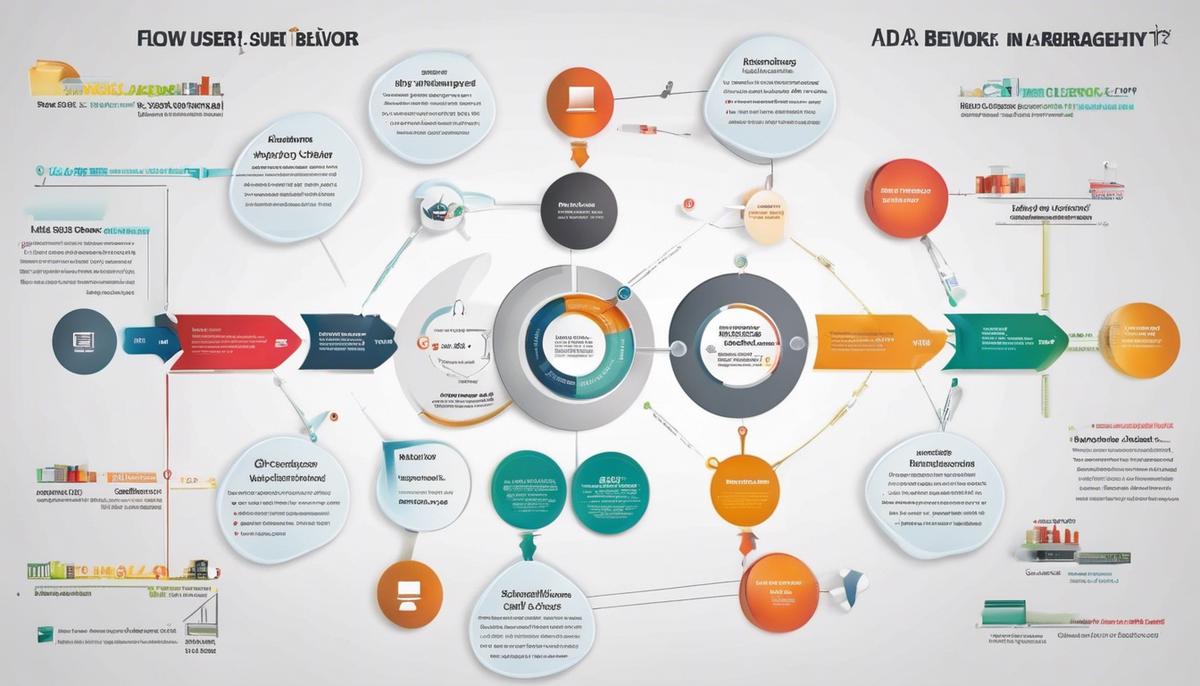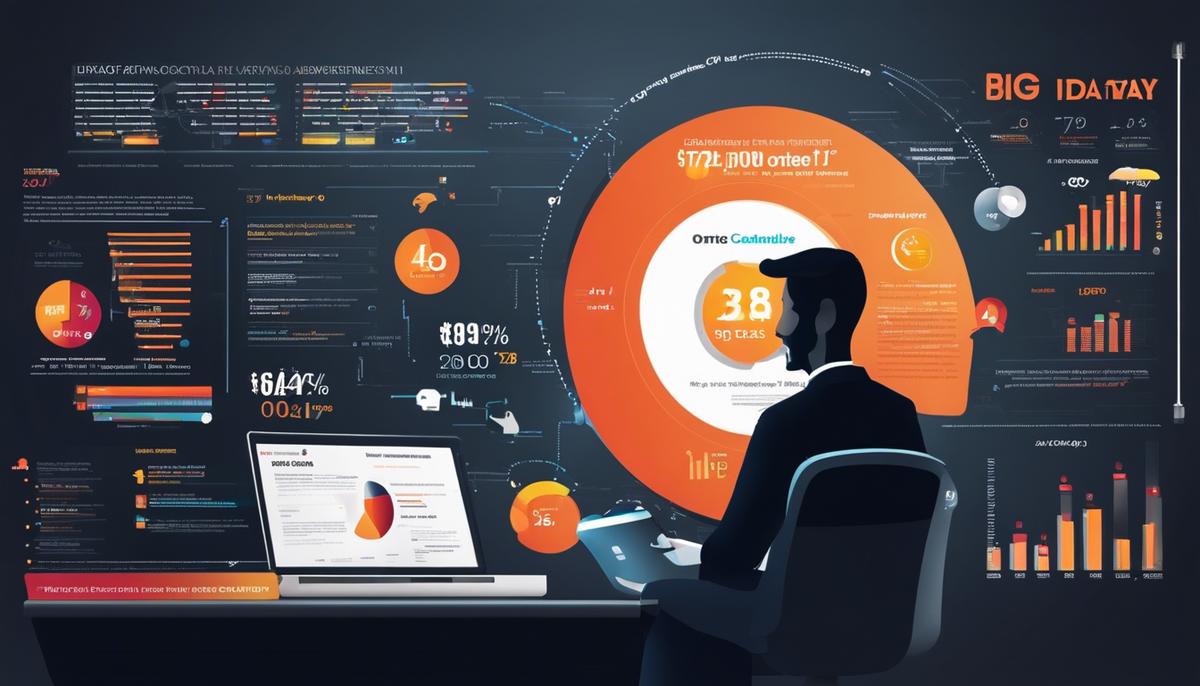
As we dive into the intricate tapestry of the digital marketplace, a fundamental truth emerges: understanding user behavior is more than a competitive edge—it’s the cornerstone of modern ad targeting. With the emergence of sophisticated analytics tools, marketers now have the unprecedented ability to track user interactions with a finesse that borders on the clairvoyant. This essay embarks on a journey through the realms of big data and the ways it shapes our understanding of audience patterns, dissecting the nuanced psychological and demographic strata that inform how advertisers craft compelling narratives tailored to resonate with individuals’ unique tastes and values. Moreover, we’ll traverse the rapidly evolving landscape of technology, where AI, AR, VR, and programmatic platforms redefine engagement, all while confronting the contentious maze of ethics and privacy that underpin this digital evolution.
Understanding User Behavior
Leveraging User Behavior for Precision Ad Targeting
In an era where the attention economy dictates market success, understanding user behavior has become the holy grail for ad targeting. Businesses are continuously honing smart strategies to dive into the psyche of their consumers, aiming to serve them the exact advertisements that resonate with their preferences and intentions. This isn’t just a game of hit-or-miss; it’s a strategic exploration where data is king.
Consumer behavior is a treasure trove of insights. It reveals patterns such as browsing habits, purchasing history, and even time spent on specific content. This data forms the backbone of behavioral targeting-ad campaigns that don’t just aim to reach an audience but seek to connect with them at a moment when their interest is piqued.
First, let’s zero in on browsing habits. With each click, users leave digital footprints that mark their journey across the web. Algorithms track these breadcrumbs to construct user profiles, painting a picture of individual preferences and needs. When someone spends an hour researching laptops, don’t just see a potential buyer. See an opportunity to showcase the latest tech deals or gadget accessories that coincide with this newfound interest.
Next up, we’ve got purchasing history-the advertiser’s dynamic roadmap. Past purchases illuminate future needs. People who bought running shoes six months ago might now be in the market for fitness trackers. By understanding these cyclical purchasing patterns, companies can hit the mark with ads that are equal parts timely and relevant.
Then, there’s the engagement factor. Time spent interacting with content is highly revealing. Engage users who devour cooking videos with advertisements for cooking classes or high-end kitchenware. Recognize that these viewers are likely passionate about culinary arts and target them with offers that spice up their cooking game.
Beyond the basics, sophisticated algorithms also factor in life events. Major changes such as a recent move, a marriage, or the birth of a child create new consumer needs. Precision ad targeting pounces on these shifts, offering up ads for home furnishings to new homeowners or baby products to new parents at just the right time, steering clear of the impersonal, blanket advertising approaches of yore.
The crucial piece to master in behavioral ad targeting? Balance. Users want relevance, not intrusiveness. They value personalization, but they also treasure their privacy. The secret sauce is to curate ads that feel like a natural step in the user’s online journey, not an unsolicited detour.
As the landscape evolves, staying agile is non-negotiable. Tracking the ebb and flow of user behavior is a continuous process. Keeping tabs on the latest trends in consumer technology usage and adapting strategies is part and parcel of the game. Moreover, the age of multi-screen users means harmonizing ad experiences across devices for seamless user engagement.
In conclusion—any entrepreneur scrolling through their analytics will affirm—the sheer power of ad targeting lies in its agility to morph alongside user behavior. Tap into those insights, and the dividends could be spectacular. In the relentless pursuit of conversion optimization, reading the subtleties of consumer habits is not just smart; it’s essential for thriving in today’s fast-paced digital marketplace. And there you have it: the blueprint to converting casual interactions into sales-ready opportunities lies in the understanding and application of nuanced user behavior.

The Role of Big Data in Ad Targeting
Big Data: The Game-Changer in Ad Targeting Precision
Navigating the intricate web of ad targeting, businesses crave a leg up to ensure that every advertisement dollar is not only spent wisely but effectively. Here’s where big data dashes in, a colossal force in transforming ad targeting into an art form of precision and personalization.
In the thick of an information-rich world, crunching numbers and data sets might not sound exhilarating, but for marketing mavens, big data is nothing short of a gold mine. Fasten your seatbelts as we dive into the sheer impact of this technological marvel on the ad targeting landscape.
Demystifying Consumer Desires Through Behavioral Analysis
When it comes to user preferences, behavior is more than just a metric; it’s a narrative. And big data is the master storyteller that deciphers this narrative, unveiling patterns and desires often invisible to the naked eye. Through analytics, businesses can uncover the ‘why’ behind consumer actions—delineating needs and interests with amazing clarity and leveraging this insight for targeted ad campaigns that resonate deeply and drive action.
Channeling Prior Purchases into Predictive Power
With every transaction, consumers leave breadcrumbs of data trailing behind them—a trail ripe for analysis. Big data effortlessly scoops up these breadcrumbs, empowering brands to forecast future purchases with striking accuracy. Predictive algorithms curate ads that align with anticipated needs, transforming the once-hazy crystal ball into a clear-cut projection of consumer behavior. Customers find themselves engaging with ads that seem custom-crafted for their upcoming life moments, cementing brand loyalty and propelling conversion rates skyward.
Cultivating Connections Through Content Interaction
Content is the banquet at which the audience feasts, but it’s big data that rolls out the red carpet. By sifting through the sands of content engagement, brands paint a portrait of individual tastes and preferences. This intricate appreciation allows for the fine-tuning of ad materials, ensuring they strike the perfect chord. As users consume content, they unwittingly steer the direction of advertisements they’ll encounter next, thanks to the silent conductor that is big data.
Deploying Device Synergy for Uninterrupted Engagement
The device-agnostic nature of today’s digital world calls for an ad targeting approach that flows as smoothly as an orchestral symphony. Big data orchestrates this multi-device harmony, synthesizing signals from a barrage of gadgets into a unified user profile. An ad seen on a smartphone in the morning finds its continuation on a desktop at noon and reaches a crescendo on a tablet by night. Fluidity in the user experience is now an expectation, not a luxury—and big data delivers just that.
The Art of Converting Passivity into Purchases
The magic of big data isn’t solely in the numbers—it’s in the narrative arc that turns a passive scroller into an active shopper. Analytics serve as the bridge between chance encounters and calculated conversions. Capitalizing on casual interactions, big data equips advertisers with the know-how to nurture leads down the funnel to a climactic point of purchase.
In the realm of advertising, big data isn’t a background actor—it’s the protagonist that commands the spotlight. It’s the fuel that powers targeting engines, driving campaigns toward ever-more-personalized heights. From behavioral analysis to multi-device engagement, big data remains the beating heart of modern-day ad targeting, pulsating with possibilities for those savvy enough to harness its potential. Get ready for a future where ads are not just seen but felt, where they speak directly to the heart of desire—thanks to the monumental might of big data.

Psychographic and Demographic Targeting
Harness the Power of Psychographics and Demographics for Superior Ad Targeting
Gone are the days of casting a wide net and hoping for the best in advertisement targeting. The modern landscape calls for precision, reaching the right audience at just the right time. Enter the dynamic duo of psychographics and demographics—two critical elements that, when combined, craft a near foolproof method for pinpointing your target market and delivering content that resonates deeply.
Unpacking Demographics: The ‘What’ of Consumer Profiles
Let’s dive into demographics. We’re talking age, gender, occupation, income, marital status—the hard facts that provide a snapshot of who consumers are on paper. It’s undeniably useful, giving advertisers a baseline for their audience. Yet, demographics only paint part of the picture. To fully understand how to captivate and motivate an audience, one must delve deeper into the minds and hearts of consumers—and that’s where psychographics come into play.
Decoding Psychographics: The ‘Why’ Behind the Behaviors
Psychographics touch upon the psychological aspects of consumer behavior. This is where it gets intriguing. Picture interests, attitudes, values, lifestyles, and opinions shaping a more vivid and actionable image of the consumer. It answers the tantalizing question of “Why?”—why they prefer specific products, why certain messages resonate, and why they choose one brand over another. It’s the key to unlocking a treasure trove of personalized marketing potential.
Fusing Facts with Feelings: A Synergistic Approach
Pair demographics with psychographics and you’ve got a recipe for success. Imagine fine-tuning your campaign to reach young professionals (demographic) who value sustainability and a minimalist lifestyle (psychographic). That’s advertising gold! By tailoring messages that align with both the identity and mindset of consumers, the chances of engagement and conversion skyrocket.
Laser-Targeted Campaigns: The Real-World Implications
Share. Click. Buy. The cycle of digital engagement is ready to roll when ads hit their mark. Let’s say a travel agency targets ads for adventure tourism to thrill-seekers with a high disposable income. By using demographic and psychographic data, they can curate content about exotic destinations that align with that audience’s sense of adventure and financial reach. It’s this kind of targeted strategy that separates the good from the exceptional in advertising.
A/B Testing: Demographics vs. Psychographics
It’s about intelligent experimentation. A/B testing with a demographic variable—testing two age groups, for instance—can reveal how each reacts to the same ad. Contrast that with testing an ad featuring value-driven content (say, eco-friendliness) versus a more generic message. This psychographic test can shine a light on which values trigger a response, refining future campaigns like a well-oiled machine.
The Future of Ad Targeting: Trends to Watch
With technology’s rapid advance, data becomes more nuanced and targeting more sophisticated. Look out for machine learning algorithms that tailor ads in real-time based on an intricate dance of demographic and psychographic signals. The potent combination of both forms of data is transforming the advertising terrain into an ever more personalized and effective domain.
Capturing the Zeitgeist: A Final Thought
Remember, insights gleaned from demographics and psychographics don’t just help to serve ads—they’re about capturing and reflecting the zeitgeist in your marketing efforts. By understanding the ‘who’ and ‘why’ of your audience through these twin lenses, a brand doesn’t just advertise; it connects, it resonates, it becomes a part of the conversation. That’s the power at your fingertips when you wield the formidable tools of psychographics and demographics in ad targeting.

Emerging Trends in Ad Targeting Technology
In the dynamic realm of ad targeting technology, we find ourselves front and center of a revolution that’s consistently on the move. As advertisers and marketers, staying ahead is not just beneficial; it’s imperative. But what exactly does the future hold for this sector? Let’s leap into the newest trends in ad targeting tech that are shaping the marketing landscape and their potential impact on the industry.
Voice Search Optimization: Speaking of Trends
Voice search technology has become an integral part of our daily lives. As more people turn to voice-activated assistants for their search queries, the focus shifts to optimizing ads for conversational keyword phrases. The impact? A whole new level of personalization that aligns with natural speaking patterns, offering a direct path to consumers’ ears and, subsequently, their wallets.
Machine Learning and AI: The Brainy Side of Ads
Machine learning and artificial intelligence aren’t just buzzwords. This tech is refining the way ads learn from user interactions. The AI-driven ads harness complex algorithms to predict user behavior, enabling real-time bidding adjustments and personalization at scale.
Privacy-First Targeting: Trust is the New Currency
With growing concerns around privacy, ad tech is pivoting towards strategies that respect user anonymity. Contextual targeting is making a comeback, allowing ads to appear alongside relevant content without relying on personal data. Additionally, new ID solutions are surfacing post-cookies, keeping ads relevant without invading privacy.
Augmented Reality Ads: A World Beyond the Screen
Imagine trying on a pair of glasses or visualizing furniture in your home before making a purchase—Augmented Reality (AR) ads are turning this into reality. This trend is redefining engagement by enabling immersive experiences that captivate users and bridge the gap between the digital world and actual touchpoints.
Blockchain in Advertising: An Unhackable Ledger of Trust
Blockchain isn’t just for cryptocurrencies. In ad targeting, blockchain’s decentralized ledger can combat fraud, ensure transparency, and verify the authenticity of ad delivery. This technology promises a more honest and efficient market, where trust is paramount, and accountability is non-negotiable.
Shoppable Ads: The Instant Gratification Game-Changer
Why wait when you can shop now? Shoppable ads incorporate seamless purchasing links within the ad content—be it images, videos, or social media posts. This minimizes the steps from discovery to purchase, catering to the evolving consumer who wants immediacy with less effort.
Interactive Ads: Dare to Engage
Engagement is the name of the game, and interactive ads are the playmakers. These ads invite users to swipe, click, and play, making ad interaction a delightful experience rather than a chore. This engagement leads to increased brand recall and a higher likelihood of conversion.
Cross-Platform Alignment: Consistency is Key
As consumer touchpoints expand across various devices, ad targeting must adapt. Cross-platform targeting technologies ensure a cohesive message and experience, no matter where or how the audience encounters the ad. This unified approach delivers consistency and strengthens the overarching narrative.
In our high-tech marketing ecosystem, ad targeting technology is rapidly evolving. Staying attuned to these emerging trends is not just a matter of staying relevant; it’s about being a trailblazer in an ever-competitive landscape. As consumer behaviors shift and technology advances, the ability to deliver precise, engaging, and respectful advertising is what will separate the industry leaders from the followers. Let’s embrace the new, harness its potential, and shape the experience that moves consumers—turning every targeted impression into an opportunity that resonates and results.

Ethics and Privacy in Ad Targeting
Navigating the Ethical Maze of Ad Targeting: Balancing Smart Strategy and Consumer Rights
In the whirlwind of digital marketing, the confluence of ethics, privacy laws, and ad targeting is creating a terrain that’s increasingly complex to navigate. Businesses, in their quest to catch the consumer’s eye, must tread carefully to strike a balance between smart advertising strategies and the individual’s right to privacy.
The ethical considerations of ad targeting hinge on respect for consumer autonomy and confidentiality. While knowledge of user behavior is pivotal for precision in ad targeting, marketers must consider the boundaries of what is deemed respectful and what could be intrusive. Privacy is not just a personal preference but a right; one that is backed by various laws and regulations designed to protect consumers’ digital footprints.
Privacy laws present a regulatory labyrinth with regional variations—think GDPR in the European Union, CCPA in California, or PIPEDA in Canada. These legislations embody the public’s demand for a digital space where privacy is not just an afterthought but a foundational element. Advertisers are now faced with the need to ensure compliance, which necessitates transparent data collection methods, clear consent mechanisms, and the empowerment of users to control their data.
Factor in the continuous evolution of technology, and businesses have at their disposal an array of sophisticated tools for ad targeting. This tech-driven approach, however, introduces its own set of ethical questions: How much personalization is too much? At what point does a well-targeted ad become a creepy one? The smart application of analytics should inform strategies that are not only effective but also considerate of the end-user’s comfort and preferences.
For marketers, the challenge is to harness the wealth of user data without overstepping ethical lines. It’s a delicate balance—knowing enough to engage consumers in a meaningful way, but not so much that it feels invasive. Integrity becomes a currency in the ad targeting realm, with consent-based marketing taking center stage. Crafting campaigns that ask for user participation, rather than presuming it, represents a shift towards a more ethical approach to advertisement personalization.
Moreover, a value-based advertising strategy takes into account ethical considerations. It’s about aligning brand messages with consumer values, creating a connection beyond the mere transactional. Ads that resonate on a personal level do more than sell—they cultivate loyalty, and in an era where consumers vote with their wallets, this can be a powerful differentiator.
In closing, the interplay between ethics, privacy laws, and ad targeting is not just a topic for compliance officers or legal teams—it’s a critical piece of the marketing puzzle that demands attention, creativity, and a proactive stance from businesses seeking to engage with modern consumers. With regulations serving as guardrails, and ethics as the guiding compass, the future of ad targeting can be both commercially successful and respectfully executed. Therein lies the sweet spot where businesses can connect with consumers not just as targets, but as individuals with choices, preferences, and a right to privacy.

The realm of ad targeting is not simply a battleground for visibility; it represents a dynamic fusion of art and science where the most successful campaigns are those that honor the delicate balance between personalized engagement and respectful privacy. As advertisers navigate this constantly shifting terrain, the charge is clear: to harmonize the immense power of data analytics with a conscientious approach to consumer privacy. The insights gleaned from our exploration underscore the magnitude of responsibility resting on the shoulders of industry frontrunners. Embracing innovation while upholding ethical standards isn’t just a lofty ideal—it’s the key to sustaining the trust and loyalty of an increasingly discerning global audience.










